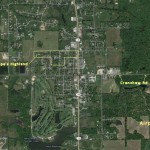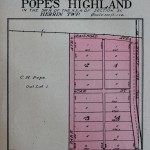Pope’s Highland, a residential sub-division in section 31 of Herrin Township, was surveyed August 29, 1907 for Charles H. Pope of Herrin. After it was built up, it was incorporated as a part of Fordville.
 In 1902 the Carterville Mining Company sank three mines in the neighborhood, at the south outcrop of the Herrin coal field. Samuel H. Bundy, Charles Owen, and Billy Bowman of Carterville were partners in the enterprise. The Coal Belt Electric Railroad served these mines, and a part of its right of way was given by Mr. Pope. But the carline was unable to handle the entire output of the three mines, and the Carterville Company built what the railroad men nicknamed the Highline switch, from Sunnyside to their mine in section 32, which became Taylor 1 of Energy. This Highline switch was turned over to the Illinois Central railroad when it was ready for the rails to be laid, sometime in 1906.
In 1902 the Carterville Mining Company sank three mines in the neighborhood, at the south outcrop of the Herrin coal field. Samuel H. Bundy, Charles Owen, and Billy Bowman of Carterville were partners in the enterprise. The Coal Belt Electric Railroad served these mines, and a part of its right of way was given by Mr. Pope. But the carline was unable to handle the entire output of the three mines, and the Carterville Company built what the railroad men nicknamed the Highline switch, from Sunnyside to their mine in section 32, which became Taylor 1 of Energy. This Highline switch was turned over to the Illinois Central railroad when it was ready for the rails to be laid, sometime in 1906.
Mr. Pope had his sub-division laid off southwest of the Highline switch-Coal Belt intersection. He called the north boundary along Highline switch Railroad Avenue, and the road bisecting the sub-division Car Street, while Park Avenue of Herrin was extended along the western line. Houses were built facing the carline from Pope’s (now Taylor) crossing to Fordville. The mines became Hafer and Taylor 1 and 2; Fordville became Energy. When Sneed highway (Rt. 148) was routed past the backs of the houses in Pope’s Highland, they were turned around to face the paved road that succeeded the carline.
Charles H. Pope (1861-1928) was the eldest son of the miller at Herrin’s Prairie and a grandson of Dr.
Benjamin Ward Pope (1806-1868) who gave his name to another prairie that became the site of Ziegler. Doctor Pope had a grist and saw mill near his home, run by his second son William Jasper Pope (1832-1867). Miller Pope married the daughter of Harrison’s Mill owner and their first child was born on Pope’s Prairie in Franklin County. When the timber was sawed out on the original mill site, the building was taken down and moved to Mrs. Pope’s old home. The great 12 x 12 timbers were dragged across country by ox teams and the mill rebuilt on Herrin’s Prairie. In a little room of this dusty third story the Masonic Lodge and the farmers Grange of Herrin’s Prairie met.
Three more children were born to Will and Louisa Pope before the father died in 1867. They were Mary, Benjamin Albert and Sarah Emmeline. The two daughters taught at Stotlar School. Ben A. Pope was his brother’s partner in a hardware store during the early day of the village and city of Herrin.
See also, Energy and Fordville
(Extracted from Pioneer Folks and Places, Barbara Barr Hubbs, 1939, on sale at the Williamson County Museum)

